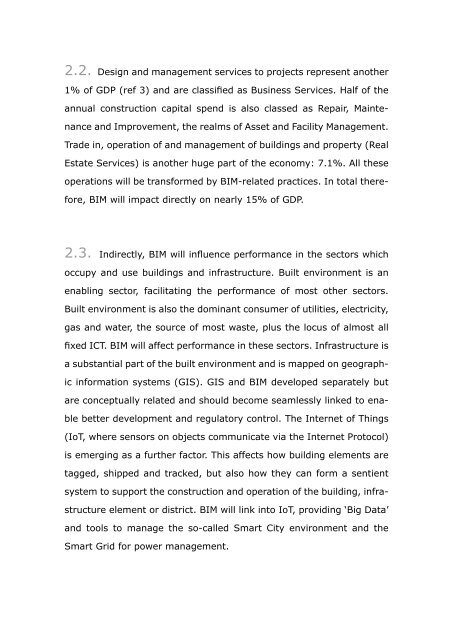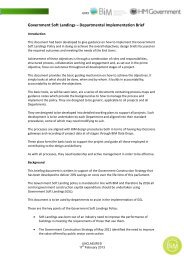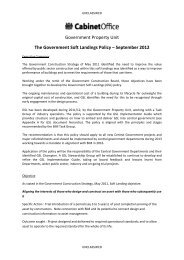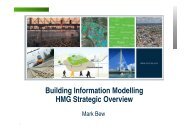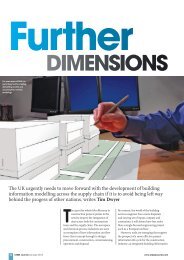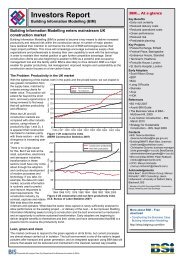Growth through BIM - Institution of Civil Engineers
Growth through BIM - Institution of Civil Engineers
Growth through BIM - Institution of Civil Engineers
- No tags were found...
You also want an ePaper? Increase the reach of your titles
YUMPU automatically turns print PDFs into web optimized ePapers that Google loves.
2.2. Design and management services to projects represent another1% <strong>of</strong> GDP (ref 3) and are classified as Business Services. Half <strong>of</strong> theannual construction capital spend is also classed as Repair, Maintenanceand Improvement, the realms <strong>of</strong> Asset and Facility Management.Trade in, operation <strong>of</strong> and management <strong>of</strong> buildings and property (RealEstate Services) is another huge part <strong>of</strong> the economy: 7.1%. All theseoperations will be transformed by <strong>BIM</strong>-related practices. In total therefore,<strong>BIM</strong> will impact directly on nearly 15% <strong>of</strong> GDP.2.4. The major opportunity for UK-based construction businessesin the current decade is to win work in the expanding markets <strong>of</strong> thedeveloping world. Currently about £7.6Bn is earned by export, around1% <strong>of</strong> contracting work, 4% <strong>of</strong> consultancy and 10% <strong>of</strong> materials andproducts business. Global Construction 2020 (ref 4) in 2011 set outthe expectations <strong>of</strong> a team <strong>of</strong> economists for the pattern <strong>of</strong> demand inthe current decade. This forecast might now be considered somewhatoptimistic about recovery from the recession, but its pattern <strong>of</strong> relativepositions is still relevant. Demand flows from a combination <strong>of</strong> populationgrowth and its urbanisation rate, economic growth and propensity2.3. Indirectly, <strong>BIM</strong> will influence performance in the sectors whichto invest in construction as a proportion <strong>of</strong> GDP.occupy and use buildings and infrastructure. Built environment is anenabling sector, facilitating the performance <strong>of</strong> most other sectors.2.5. Global Construction 2020 says that the annual amount <strong>of</strong>construction to be done globally will rise to $12tn in 2020, up 67%from 2010 and forming 13.2% <strong>of</strong> world GDP. $97tn will be spent inthe decade. The growth will come entirly from the developing world;Built environment is also the dominant consumer <strong>of</strong> utilities, electricity,gas and water, the source <strong>of</strong> most waste, plus the locus <strong>of</strong> almost allfixed ICT. <strong>BIM</strong> will affect performance in these sectors. Infrastructure isa substantial part <strong>of</strong> the built environment and is mapped on geographicinformation systems (GIS). GIS and <strong>BIM</strong> developed separately butare conceptually related and should become seamlessly linked to enablebetter development and regulatory control. The Internet <strong>of</strong> Things(IoT, where sensors on objects communicate via the Internet Protocol)is emerging as a further factor. This affects how building elements aretagged, shipped and tracked, but also how they can form a sentientsystem to support the construction and operation <strong>of</strong> the building, infrastructureelement or district. <strong>BIM</strong> will link into IoT, providing ‘Big Data’and tools to manage the so-called Smart City environment and theSmart Grid for power management.Wuxi Shopping Centre, atrium, for Inter Ikea Centre GroupG r o w t h t h r o u g h B I M15


